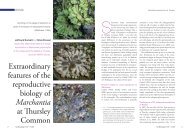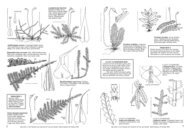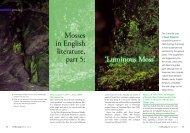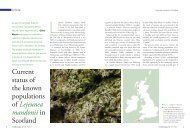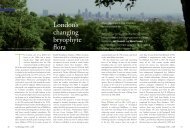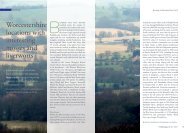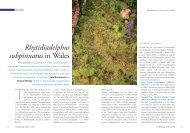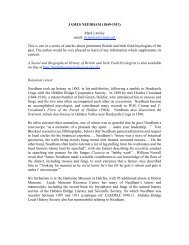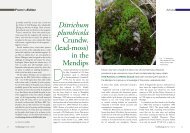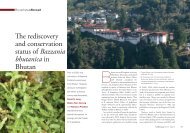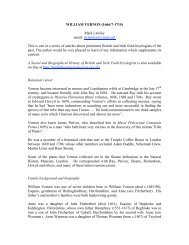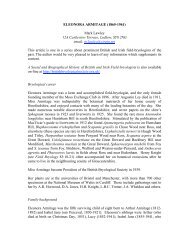Bryological Monograph An annotated checklist of the mosses of ...
Bryological Monograph An annotated checklist of the mosses of ...
Bryological Monograph An annotated checklist of the mosses of ...
You also want an ePaper? Increase the reach of your titles
YUMPU automatically turns print PDFs into web optimized ePapers that Google loves.
Table 3. Non-native <strong>mosses</strong> in Europe.<br />
Species Location<br />
combinations are given in <strong>the</strong> second edition <strong>of</strong> his flora<br />
(Smith, 2004).<br />
Heterocladium flaccidum (Schimp.) A.J.E.Sm., stat. et<br />
comb. nov. Basionym: Heterocladium heteropterum var.<br />
flaccidum Schimp. in Bruch, Schimp. & W.Gümbel,<br />
Bryologia Europaea 5: 154 (fasc. 49–51). 1852.<br />
Hypnum cupressiforme var. heseleri (<strong>An</strong>do & Higuchi)<br />
M.O.Hill, stat. et comb. nov. Basionym: Hypnum heseleri<br />
<strong>An</strong>do & Higuchi, Journal <strong>of</strong> <strong>the</strong> Hattori Botanical<br />
Laboratory 75: 98. f. 1–2. 1994.<br />
Pelekium atlanticum (Hedenäs) Hedenäs, comb. nov.<br />
Basionym: Thuidium atlanticum Hedenäs, Journal <strong>of</strong><br />
Bryology 16: 387. f. 1–2. 1991.<br />
Pohlia flexuosa var. pseudomuyldermansii (Arts,<br />
Nordhorn-Richter & A.J.E.Sm.) A.J.E.Sm., comb. nov.<br />
Basionym: Pohlia muyldermansii var. pseudomuyldermansii<br />
Arts, Nordhorn-Richter & A.J.E.Sm. Journal <strong>of</strong> Bryology<br />
14: 642. f. 3. 1987.<br />
Weissia6mittenii (Bruch & Schimp.) Mitt. emend.<br />
A.J.E.Sm., stat. nov. Basionym: Weissia mittenii (Bruch &<br />
Schimp.) Mitt., <strong>An</strong>nals and Magazine <strong>of</strong> Natural History,<br />
ser. 2, 8: 317. 1851.<br />
Planta originis hybridae. Parens feminea Weissia multicapsularis.<br />
Parens mas forte W. rostellata.<br />
Composition <strong>of</strong> <strong>the</strong> moss flora<br />
The moss flora comprises 1292 species in 278 genera, 71<br />
families and 22 orders. In addition, we recognize 46<br />
subspecies and 118 varieties. Of <strong>the</strong> total 1292 species, 53<br />
are confined in Europe to <strong>the</strong> Atlantic islands <strong>of</strong><br />
Macaronesia (Table 2). In addition, Bryoxiphium norvegicum,<br />
Didymodon brachyphyllus and Polytrichastrum<br />
MOSSES OF EUROPE AND MACARONESIA 201<br />
Achrophyllum dentatum Garden, England<br />
Atrichum crispum Britain and Ireland, widespread (male only)<br />
Bryum apiculatum Tenerife<br />
Bryum valparaisense Canary Islands, Portugal<br />
Calomnion complanatum Garden, Ireland<br />
Calyptrochaeta apiculata Britain, rare<br />
Campylopus intr<strong>of</strong>lexus C. and W. Europe, widespread<br />
Hennediella macrophylla Britain, widespread and spreading<br />
Hennediella stanfordensis Britain and Ireland, widespread and spreading<br />
Hypopterygium tamarisci Portugal<br />
Leptophascum leptophyllum Widespread in S. and W. Europe, apparently spreading<br />
Lepto<strong>the</strong>ca gaudichaudii Garden, Ireland<br />
Myuroclada maximowiczii Garden, sou<strong>the</strong>rn Russia<br />
Orthodontium lineare C. and W. Europe, widespread<br />
Sematophyllum adnatum Lombardy and Piedmont, several localities<br />
Splachnobryum obtusum Hot springs, Hungary and Azores; elsewhere in greenhouses<br />
Syntrichia bogotensis Madeira<br />
Tortula amplexa Britain, confined to one small area<br />
Tortula bogosica Azores and Canaries<br />
Tortula bolanderi S. Europe (rare), Macaronesia<br />
Thuidiopsis sparsa Madeira, in a former park area<br />
sphaero<strong>the</strong>cium are confined to Iceland, and Bryum<br />
miniatum to <strong>the</strong> Faeroe islands.<br />
In <strong>the</strong> east and south-east, several species are known only<br />
from Russia, mainly from <strong>the</strong> Urals and <strong>the</strong> Caucasus. In<br />
Asia just outside Europe, Crumia latifolia, Tortula caucasica<br />
and Trichostomum connivens are known from <strong>the</strong><br />
Caucasus. <strong>An</strong> additional eight species are listed by<br />
Kürschner & Erdag˘ (2005) from <strong>An</strong>atolia.<br />
Twenty-onespecies<strong>of</strong>mossarethoughttohavebeen<br />
introduced to Europe by human agency (Table 3), a<br />
remarkably small number. Mosses must have been<br />
introduced from <strong>the</strong> Americas, especially to Macaronesia,<br />
before moss recording began; but invasions before<br />
1900 would not have been noticed. No non-native species<br />
is known to have arrived before 1800, though Corley &<br />
Frahm (1982) have speculated that Campylopus pyriformis<br />
is a late 18th century introduction from <strong>the</strong> Sou<strong>the</strong>rn<br />
Hemisphere. Indeed, <strong>the</strong> only alien known to have reached<br />
Europe before 1900 is <strong>the</strong> North American Atrichum<br />
crispum, which has spread slowly and is probably a single<br />
clone. There are several o<strong>the</strong>r species that may be<br />
introduced. For example Bryum gemmiferum, now widespread<br />
in central and west Europe, appears still to be<br />
spreading, and lacks pre-1940 records (Herman<br />
Stieperaere, pers. comm.).<br />
TAXONOMIC HIERARCHY<br />
The main source for <strong>the</strong> hierarchy is G<strong>of</strong>finet & Buck<br />
(2004). A few genera have been moved between families to<br />
take account <strong>of</strong> suggestions from Ignatov and Hedenäs or<br />
where <strong>the</strong>re is evidence from newer molecular phylogenies.<br />
The following classes and orders occur in Europe. Orders<br />
are included in <strong>the</strong> list <strong>of</strong> taxa, below.



